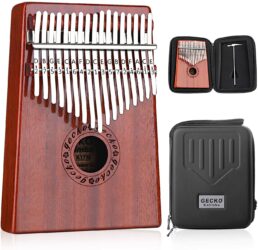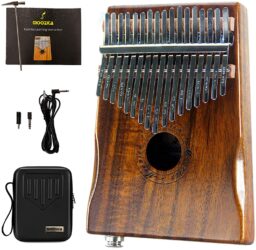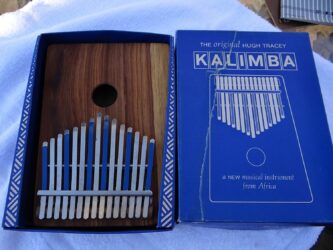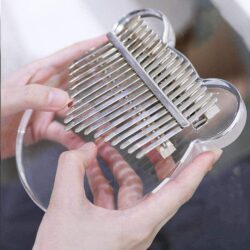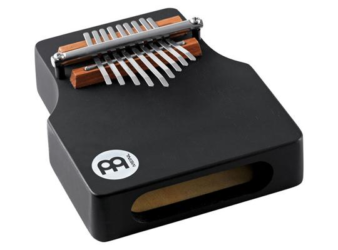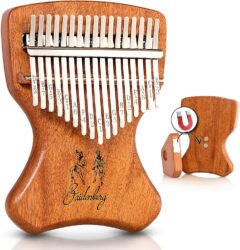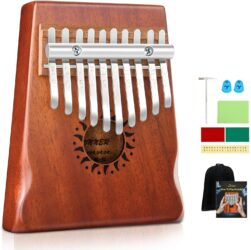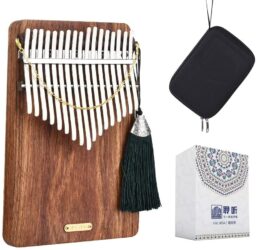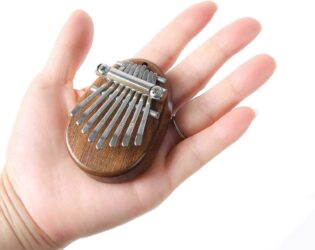You may not have ever heard of a kalimba, but it’s one of the easiest to play melodic instruments around. Sometimes called a thumb piano, a kalimba is an instrument invented by an English man that spent his life studying African music. It produces a haunting ring that can often be found in relaxation music or accenting dramatic moments in movies. It’s also incredibly intuitive to play, and you should have one.
In this guide, we’ll start by telling you about the kalimba and what to look for when buying one for yourself. Then we have put together a list of popular kalimbas, along with our thoughts, so you can easily pick one and get right into playing. In the end, we have a guide to you get started on this new musical journey and a list of some frequently asked questions with answers.
- Buying a Kalimba
- Top 10 Best Kalimbas 2024
- 1. Best Overall: Gecko 17 Keys Thumb Piano
- 2. Overall Alternative: Moozica 17 Keys Electric Kalimba
- 3. Best Premium: Hugh Tracey Alto Kalimba
- 4. Best for Children: Transparent Acrylic Mbira
- 5. Best Budget: Huawind Kalimba
- 6. Great for Experimenting: Meinl Percussion Wah-Wah Kalimba
- 7. Ergonomic and Solid: Zaidenberg Kalimba
- 8. Easiest to Play: Donner 10 Key Kalimba
- 9. Tons of Sustain: LingTing LT-K17P
- 10. Mini Travel Sized:: 8 Key Mini Kalimba
- FAQ
- Getting Started With Kalimbas
- Get Those Thumbs Warmed Up
Buying a Kalimba
One of the best things about a kalimba is that anyone can pick one up and get right into playing. They are tuned diatonically, so no matter what order you pluck the notes in, you will quickly build beautiful harmonies and simple melodies. If you are thinking of buying one, that simplicity means there are only a few things you need to know before diving in. First things first, though, as many people have never heard of a kalimba, let’s get you acquainted.
What Is a Kalimba?
A kalimba is an instrument derived from a family of African instruments known as mbira. It belongs to a class of lamellophone, which means it has metal tines attached to a box. Some boxes have soundholes, while others are solid. You pluck the tines with your thumbnail. They are usually tuned to a specific scale and thus only have a few notes you can play.
They also sound beautiful. Here is kalimba musician April Yang playing a popular theme from Spirited Away. This video also does a great job showing you exactly how the instrument is played using some great closeups of her hands.
What to Look For When Buying a Kalimba
A kalimba is a straightforward instrument. Unfortunately, that can make choosing one difficult. They are all very similar, so the deciding factor will come down to a few small details that will make it better for you. Generally, these details fall into one of the following categories.
Skill Level
Your skill level will probably be one of the biggest determining factors when choosing a kalimba since it’s closely tied to cost.
- Beginner kalimbas are inexpensive and usually don’t have the attention to detail in the build that a more expensive instrument would have. These are perfect for children, people who aren’t sure if they want to commit to learning a new instrument, and people just looking for something to throw in a travel bag and not worry too much.
- Intermediate kalimbas make up a bulk of kalimbas on the market. Since kalimbas are simple, these can be very high quality without making it into triple-digit prices. If you are more serious about learning or have experience with other instruments, get an intermediate kalimba instead of a cheaper beginner one.
- Advanced or professional level kalimbas can be very pricey, but they make excellent showpieces, sometimes even more art than instrument. An expensive kalimba in this category will sound very similar to an intermediate kalimba, but it may be made of much higher quality figure woods or have intricate, specialized tines.
Style
Along with the price, another important feature related to a kalimba is how it looks. This category is very subjective; each person has their own taste. If you see a certain instrument in your price range and you really like the looks, you won’t be disappointed.
Part of the style is also the size of the kalimba. Generally, smaller kalimbas are harder to play because the tines will be closer together. Usually, smaller instruments will have fewer tines, so they are not crowded, but it means you’ll have fewer notes at your disposal. The most common number of keys is 17; however, small kalimbas can have as few as 8, while gigantic chromatic kalimbas have 40 or more tines.
Type
There are primarily three different types of kalimbas.
- Soundbox, or hollow, kalimbas have a wood chamber for air like an acoustic guitar. They are louder than solid kalimbas.
- Solid kalimbas are usually made of wood but can actually be made out of any stable material, including plastic. They have more sustain but are quieter.
- Electronic kalimbas have onboard electronics, so they can be plugged into FX pedals and amplifiers.
Like we said, simple. The following top ten list, along with the reviews, was built using two separate metrics. The first is simply ranking them by how good we think the value is. That doesn’t mean cheap; it means we try to dive into if the sound and looks are worth the cost for some reason. The second thing we tried to do is make sure there’s a good variety of styles and shapes so you can find a kalimba that really speaks to you.
Top 10 Best Kalimbas 2024
1. Best Overall: Gecko 17 Keys Thumb Piano
Why we like it:
It’s the perfect combination of quality, price, and looks. You can’t go wrong with this regardless of if you are a beginner or a seasoned player.
Quick Specs:
- Level:Intermediate
- Tines:17
- Material:Mahogany
- Type:Hollow
- Give it a ListenYoutube
Standout Feature
It comes with a hardshell case and a songbook, but it’s really the convergence of sound quality and price that make the Gecko stand out. There are not many kalimbas that have better sound quality, and the very few that do will cost you a lot more.
Our Review
If you are new to kalimbas but not new to playing instruments, then get this one. If you are new to instruments but are sure you really want to learn, get this one. If you have other kalimbas and are just wanting to add a nice hollow body instrument to your collection, get this one.
There are only a few reasons you would want to go with a different kalimba. The first is that it’s a relatively plain instrument. It’s not particularly beautiful, and it doesn’t have any unique features. If you value standing out, consider something like the Wah-Wah kalimba on our list instead.
The other reason is if you expect it to take a lot of abuse. A solid kalimba, especially one made of plastic like this one, is much more durable than a hollow kalimba that can easily break if dropped.
Pros
- Outstanding sound quality
- Very good value
- Comes with a lot of neat accessories
Cons
- On the fragile side
- A little plain
2. Overall Alternative: Moozica 17 Keys Electric Kalimba
Why we like it:
Kalimbas are fairly quiet instruments. This one, though, has a pickup like an electric-acoustic guitar so that you can hurt some eardrums with soothing music.
Quick Specs:
- Level:Intermediate-Advanced
- Tines:17
- Material:Koa
- Type:Hollow Electric
- Give it a ListenYoutube
Standout Feature
The biggest reason to buy this instrument over the very similar Gecko kalimba is that it has an electric pickup. You can amplify it and add effects, which is a nice way to spice up your regular playing. We think the neatest thing to do with an electric kalimba is to plug it into a looper, though. That way, you can play very complicated melodies with this very simple instrument.
Our Review
The sound quality is good, but that’s not surprising for what ends up being a fairly expensive kalimba. It’s also finished nicely; koa is a great wood for both looks and sustaining tone. It’s a little brighter in tone than the more common mahogany, but the darker grain really makes it look great.
Other than that, the Moozica Electric Kalimba comes in a great kit. It comes with a soft case and a hard case, as well as a few convenient accessories like a tuning hammer. The instruction booklet is a bit lacking, but that’s what YouTube is for.
The electronics are what set it apart. If you want to experiment with effects or want some amplification, then this kalimba is absolutely perfect.
Pros
- Has onboard electronics
- Has a great sound quality
- Looks nice
Cons
- A little expensive
- Included instructions are mediocre
Why we like it:
Hugh Tracey is one of the original kalimba makers, and this beautiful kiaat wood instrument is a testament to their success.
Quick Specs:
- Level:Advanced
- Tines:15
- Material:Kiaat
- Type:Hollow
- Give it a ListenYoutube
Standout Feature
At the risk of sounding vain, the name stamped on the bottom is the biggest reason to buy this instrument. Hugh Tracey is the father of the kalimba. He traveled to Africa in the 20s and learned their music, then came back to England and invented the kalimba as a derivative of the traditional mbira.
Owning a Hugh Tracey kalimba is like owning a Gold Top Les Paul or Fender American Strat. It’s not necessarily the best you can buy, but it’s absolutely full of meaning.
Our Review
Let’s start with the bad news. First, the sound isn’t as incredible as you might expect. You’d probably have a hard time telling the difference between this alto kalimba and any other intermediate alto. That can be a problematic fact to get over considering the second point: it’s costly. It’s the only kalimba on our list that hits triple digits in price, and it doesn’t even include a carrying case.
That being said, it is a gorgeous instrument. Kiaat wood is only found in southern Africa, and it looks great. It’s also an alto kalimba, rather than a standard 17 key treble kalimba. That makes it a little easier to play. It also makes it easier to justify buying one for the prestige. Suppose you already have a treble kalimba and need a justification to spend a bunch on a gift to yourself. If so, an alto kalimba is a great complementary instrument.
Pros
- It’s beautiful
- They are very prestigious
- They can be easier to play
Cons
- Very expensive for a kalimba
- No included case
4. Best for Children: Transparent Acrylic Mbira
Why we like it:
The solid acrylic body gives this kalimba good sustain, but where it really shines is durability. This kalimba can survive being dropped, stuffed into a backpack with books, and even light teething.
Quick Specs:
- Level:Beginner-Intermediate
- Tines:17
- Material:Acrylic
- Type:Solid
- Give it a ListenYoutube
Standout Feature
Just by looking at it, you can probably guess this kalimba’s most unique feature: it’s clear. Acrylic is actually a material that’s often used for instruments. It’s very dense but still lightweight and easy to work with. Denser materials have good acoustic properties, so acrylic makes a good wood substitute.
The biggest advantage of an acrylic instrument is that it is incredibly durable. You can drop this kalimba and watch it skitter across the floor only to be picked up by a dog to be chewed on, and when you wrestle it back, it’ll still play just fine.
Our Review
We call it perfect for kids just because it can stand up to a ton of abuse, but it’s really for anyone. It’s unique, and some people like having things that “break the mold.” It also sounds good. Acrylic has a very bright tone and gives a solid surface for a lot of sustain.
The downside is that you won’t get as much volume as you would with a hollow offering like the Moozica kalimba. The uniqueness can also be a big turn-off. Since it has no soundbox and is made of a very workable material, the acrylic body can have any shape. This one is shaped sort of like the silhouette of a teddy bear’s head, which can be a little jarring if you are expecting the look of a traditional instrument.
Pros
- It’s very durable
- It has a very bright sound
- Some people will love the look
Cons
- Some people won’t love the look
- It’s on the quiet side
5. Best Budget: Huawind Kalimba
Why we like it:
This instrument has some flaws related to quality. However, it sounds great and is incredibly inexpensive.
Quick Specs:
- Level:Beginner
- Tines:17
- Material:Soft Wood
- Type:Hollow
- Give it a ListenYoutube
Standout Feature
This kalimba is built as inexpensively as possible. It is one of the least expensive instruments you can buy. Anyone who isn’t sure if they would enjoy playing the kalimba, or who is traveling and worried about damage/theft can buy this and not feel heartbroken if things go poorly.
Our Review
Like we said above, it does have some flaws. The sustain is a little lacking, and it doesn’t have clarity like more expensive instruments have. That’s one of the reasons we like the Gecko kalimba so much; it sounds great and doesn’t cost that much more. The Gecko is also just constructed better. Things like the sanding and clear coat on the Huawind aren’t as even or nice.
However, unlike some very cheap kalimbas, all the tines on the Huawind will ring. It’s also, unlike most very cheap kalimbas, a full 17 note instrument. That means it plays just like its more expensive rivals and can really tell you whether or not you enjoy playing. The worst-case scenario is that you fall in love with it and go buy the Gecko kalimba too, and you still won’t be breaking the bank to do it.
Pros
- It’s very inexpensive
- It’s full-sized
- It doesn’t have dead notes like many budget kalimbas have
Cons
- The fit and finish is a little lacking
- It doesn’t sound as good as others
6. Great for Experimenting: Meinl Percussion Wah-Wah Kalimba
Why we like it:
The unique looks and unique sound make it a perfect thing for adding a little bit of unique sound to your music.
Quick Specs:
- Level:Intermediate-Advanced
- Tines:9
- Material:Softwood
- Type:Hollow “Wah-Wah”
- Give it a ListenYoutube
Standout Feature
You can tell that Meinl Percussion designed this little kalimba for people that just want to play around with an instrument. It’s got a big soundhole on the front of it, instead of on the top and back like a traditional one. That big soundhole is there to encourage you to do things like press it against your belly and make a wah-wah sound effect.
It also looks ready for people that like to fiddle with sounds. It’s got a unique shape and is one of the few kalimbas on our list that doesn’t have a natural finish. Finally, it’s only got nine keys, so you can’t just rely on playing common melodies to wow an audience; you have to do something crazy with it.
Our Review
This kalimba is not for everyone. It doesn’t look traditional. It doesn’t sound traditional. It doesn’t have enough notes to be played like a traditional instrument. If the Hugh Traceys are the Stradivarius of kalimbas, this is a Theremin.
There are, however, people that will love that lack of tradition. They are the people who already have a traditional kalimba or who have other crazy instruments like an otamatone and just want something cool and unique. For those people, this thing is perfect.
Pros
- It’s really unique looking
- The wah-wah effect is a lot of fun
- The design encourages creativity
Cons
- It only has nine notes
- The uniqueness isn’t for everyone
7. Ergonomic and Solid: Zaidenberg Kalimba
Why we like it:
This solid-body instrument is very easy to hold and has great sustain. It also comes with its own magnetic stand, making it a great display piece and conversation starter.
Quick Specs:
- Level:Intermediate
- Tines:17
- Material:Mahogany
- Type:Solid
- Give it a ListenYoutube
Standout Feature
Two things make the Zaidenberg kalimba standout. The first is the one that will probably steer you towards buying it. The non-traditional shape is meant to be very comfortable to hold. Instead of having to wrap your hands around a large box, you simply nestle the bottom into your palms. The cutouts leave you plenty of room for grip, and your thumbs will naturally come together over the tines.
The second feature is less for playing and more for the show. It comes with a magnetic stand that looks a lot like a bookstand. The stand holds the kalimba upright so that you can set it on a shelf and admire it. You can also set it on your desk at work and use it as a test. See how many of your coworkers can resist plucking it every time they walk past.
Our Review
This kalimba is a great alternative to the Gecko. It’s about the same price, and it still sounds pretty good. You are mostly just trading volume for sustain with the solid body over the Gecko’s hollow body.
There are a few drawbacks. It’s not the most important thing to consider, but it doesn’t come with a nice case like other kalimbas at this price point. The bigger negative is that it may not fit your hands well. It’s designed to be ergonomic, but if you have bigger hands, you may find the shape brings your hands too close together for comfortable playing.
You won’t find that nice magnetic stand anywhere else, though. If you are trying to decide between the LingTing and this Zaidenberg for your solid body purchase, think of it more like deciding between a nice case or a neat stand.
Pros
- It comes with a presentation stand
- The ergonomic design can make holding it easier
- It sounds great
Cons
- The case is not included
- You may find the ergonomic design to be less comfortable
8. Easiest to Play: Donner 10 Key Kalimba
Why we like it:
It only has ten keys, and they are all tuned to the C scale. No matter what you pluck, it’ll sound great.
Quick Specs:
- Level:Beginner
- Tines:10
- Material:Mahogany
- Type:Hollow
- Give it a ListenYoutube
Standout Feature
You can tell they designed this little instrument with absolute beginners in mind. It doesn’t have very many notes, first off. The notes are also meant to be tuned to the C Major scale, one of the most intuitive scales. Finally, it comes with one of the better little instructional booklets.
If you are not new to instruments, like if you play guitar or piano regularly, you will probably want a kalimba with the more standard 15 or 17 tines. People who are just learning about music will really appreciate this inexpensive, straightforward instrument.
Our Review
It’s not the most budget-friendly option on our list, which may make some people turn away from it as a beginner instrument. That’s fine; the Huawind kalimba is full size and still very playable. There are some big advantages to this Donner kalimba, though.
First, the instructions and support are a lot better than the cheaper options. They even have an easy to follow tuning guide on the product page, so anyone that doesn’t want to spend extra time hunting down information will have a better time with this kalimba. It’s also smaller, which can make it a lot easier to play. People with small hands will have an easier time reaching every note, especially children that can be trusted not to drop it.
Pros
- It’s a good choice for small hands
- Donner has a lot of good documentation for it
- It’s easy to tune and play
Cons
- Seasoned musicians will want more notes
- Not as inexpensive as others
9. Tons of Sustain: LingTing LT-K17P
Why we like it:
It’s simple, sturdy, and elegant, which is enough on its own. The biggest selling point, though, is that it has amazing amounts of sustain.
Quick Specs:
- Level:Intermediate
- Tines:17
- Material:Rosewood
- Type:Solid
- Give it a ListenYoutube
Standout Feature
The LingTing solid kalimba is about as simple as you can get. It’s just tines attached to a solid block of wood. The good news is that that is the recipe for amazing note clarity and sustain. You can hear it in the sample above; the notes ring on forever. In the immortal words of Spinal Tap, “it’ll sustain for hours.”
Our Review
There’s not a lot of bad things we can say about the LingTing kalimba. We could maybe gripe about how plain it looks, but the simplicity has its own beauty. We could complain about how it doesn’t include any nice booklets, but it’s probably better to use the internet anyway.
Unfortunately, there’s also not a lot we want to really praise about LingTing either. It has a decent case, but that’s par for the course. It sounds good, but that’s also just expected at this price point. It’s a solid choice if you want a solid kalimba. If you aren’t really sure, though, stick with the Gecko. It’s more traditional and a bit more versatile.
Pros
- It has great sound qualities
- It comes with a nice case
- It has a beautiful simplicity to it
Cons
- The simplicity can make it very plain looking
- There’s nothing that makes it really stand out
10. Mini Travel Sized:: 8 Key Mini Kalimba
Why we like it:
It’s tiny and cute, but it still sounds halfway decent
Quick Specs:
- Level:Beginner
- Tines:8
- Material:Sapele
- Type:Solid
- Give it a ListenYoutube
Standout Feature
This kalimba is really tiny. In fact, you can wear it around your neck like a little musical pendant.
Usually, when musical instruments get miniaturized, they lose anything resembling quality. The tone goes out of the window, and they usually use really inferior quality materials. Kalimbas are different, though. They are such simple instruments that they really take well to shrinking, and even a pint-sized eight key instrument can have a decent tone.
Our Review
Little kalimbas make great gifts. Giving one to a young child can encourage them to make music and learn an instrument, and giving one to a musician is an inexpensive way to give a thoughtful gift.
They are hard to play, and they really don’t sound great, but that’s not the point. It’s a tiny way to show that you love the kalimba, and it doesn’t need to be more than that.
Pros
- Tiny
- Great for giving as a gift
- Still playable
Cons
- Hard to play
- Doesn’t sound amazing
FAQ
The kalimba is a very easy instrument to learn, and there isn’t much difference in function between low-end and high-end variations. Therefore, the best kalimba for a beginner is simply one that sounds good and looks good. We suggest our number one pick from Gecko.
No, although having longer thumbnails will make it easier. Some people use thumb protectors that are similar to guitar picks, and some people instead play with the pads of their thumb. However, the most common way to play is by using your thumbnails, and if your nails are cut too short, it can cause irritation.
Kalimbas are some of the easiest instruments to learn. There are two reasons. First, they are very easy to practice: they don’t need much upkeep, they are quiet, and they are compact.
Second, they are often tuned to common scales that are very intuitive to make melodies from. That means anyone can pick up a kalimba for the first time, and will be able to play a song.
If you play a bit every day, a kalimba will probably hold their tuning for a month. Since they are very stable instruments, they don’t need tuning nearly as often as string instruments like the guitar.
If you really value perfect tuning, the best thing to do is simply to have a tuner nearby and check it every few times you play. You’ll get a feel for how your specific instrument changes.
Absolutely, although there are limitations to tunings due to the length of the individual tines, it’s very similar to a guitar. You can tune each key to a range of pitches, so you can get any note in the desired scale. You just may not get them in the order you want.
Kalimbas lend themselves well to simple melodies. Songs like Twinkle Twinkle Little Star are much easier to play than, say, Mozart’s Turkish March. However, with a little creativity, there isn’t really anything you can’t play. For proof of that, just take a listen through the samples in our review section. You’ll get everything from famous movie scores to good old rock and roll.
Getting Started With Kalimbas
Once you have a kalimba in your hands, there’s really nothing else you must know before playing. Hold it out in front of you, place your thumbs on the tines, and start making music.
The following sections are here to help you get the most out of your journey, though. It’s a simple collection of tips and tricks that can help you feel confident and encourage you to try new things that will speed you along.
Before You Play
When you get a new instrument, we know that it’s hard to do anything before playing it. If you wait just a moment, though, and go over these few items, you’ll have an easier time jumping into the world of Kalimbas.
The Parts of a Kalimba
The first thing to know is simply what the parts of the instrument are called. Most are fairly obvious. The hole in a hollow kalimba is called a soundhole, and the board itself is called a soundboard. The keys, or tines, sit on a bridge just like a guitar. The tines are pressed against a backstop, which stops them from moving around too much.
The only thing that’s not super intuitive is the z-bracket. The bracket holds the tines down and in place and often looks like a z if you look at it in profile. However, some kalimbas use different shaped brackets and stops, although everyone will still know what you are talking about if you call it a z-bracket. Here is a simple diagram to help you out if you prefer some visual help.
Tuning
A standard 17-note kalimba is tuned in the key of C-major, but they probably won’t be in tune when they come to you from the factory. Kalimba Magic has a really easy to follow guide on how to tune a kalimba. The basics are that you can use the small hammer that’s often included to move the tines in and out. Lengthen them, and the note gets lower; shorten them, and the notes get higher in pitch. That’s easy enough.
Do note that you don’t have to tune your kalimba to the standard C scale. You can tune them to almost anything. Some of the other common tunings include chromatic tuning, like a piano, and an African tuning similar to the Mixolydian mode, but not quite on the pitch.
Thumbs and Thumbnails
When you are first starting out with playing, a kalimba’s hard tines can begin to hurt your thumbs. Lots of players prefer to instead grow their thumbnails out and use their thumbnails to pluck the tines. If you want, there are thumb protectors that do exactly what they sound like they do. However, some kalimba players find they do more harm than good, so your mileage may vary.
Learning to Play
It’s beyond the scope of a simple internet guide to teach you how to play an instrument. We can, however, point you in the right direction.
YouTube
YouTube is probably the best thing ever invented for learning instruments. The kalimba is no exception, as there are numerous YouTube channels dedicated to teaching you about the kalimba. April Yang, who makes an appearance in numerous samples on our list, has her own teaching series. Tip’s Kalimba and Eric J are two other good channels, and it’s nearly impossible not to encounter more talented kalimba players and kalimba based channels as you dive in.
Around the Web
There are hundreds of blogs, websites, and articles about playing the kalimba. Kalimba Magic is one of the better repositories of kalimba information, loaded with expert guidance.
Books
A lot of kalimbas you can buy online come with books. Some, like the one included with the Gecko Kalimba we recommend, are actually halfway decent. Outside of kalimba-specific books, it’s always good to grab a few on general music theory. If you have a kindle or kindle reader, this book on music theory is free, so there’s no excuse not to at least thumb through it.
Accessories
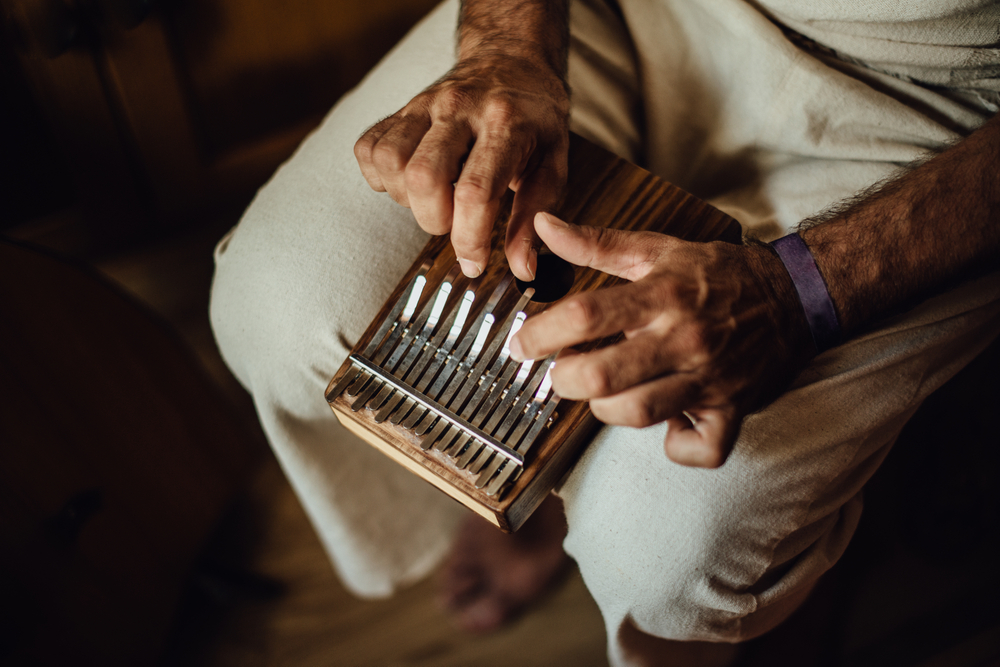
There are a handful of accessories to consider purchasing to go along with your new kalimba. A lot of kalimbas, especially the ones we recommend, come with some of these accessories. There’s always room to upgrade, though.
- A case to carry the instrument around can help protect your kalimba when you are transporting it.
- An extra tuning hammer is good to have around. They are fairly easy to lose.
- A tuner is a good thing for any musician to have around. We are fond of this one, although there are plenty of apps that can convert your cellphone into a tuner. Guitar Tuna is a popular one because it’s very easy to use.
- We mentioned them before, but thumb protectors can help keep your thumbs from ending up sore after a long playing session. You will probably outgrow them as you play, but they can help encourage you to lengthen practice sessions in the beginning.
- If you have an electric acoustic kalimba, there are a few fun accessories you can get. An amp, of course, would be the first step. A simple multi-FX box and a looper can give you a ton of options to play with and lead to hours of fun.
- A songbook can get you playing fun tunes fast and usually have great practice exercises as well.
Get Those Thumbs Warmed Up
The kalimba is a gorgeous and often underrated instrument. It’s also one of the most approachable instruments to learn, and we hope you’re inspired to give it a try. Pick one up and get plucking.

